Top Searches
- News
- India News
- India has 4.36 lakh students in Oecd-member countries, second to China with 9.7 lakh students
India has 4.36 lakh students in Oecd-member countries, second to China with 9.7 lakh students

MUMBAI: International students are an important feeder – contributing to the workforce in the host country, according to the annual migration report issued by the Organisation for Economic Co-operation and Development (Oecd).
Students who transitioned to a work permit accounted for about half of all admissions for work in France and Italy, and more than one in three in Japan. In the US, erstwhile F-1 (student visa) holders accounted for 57% of the H-1B visa recipients, meant for skilled workers.
In 2020, there were 44 lakh international students enrolled in the Oecd countries, accounting for 10% of all students in the tertiary sector (higher educational sphere). China and India continued to be the top countries of origin, 9.7 lakh (22%) were from China and 4.36 lakh (10%) from India, according to the ‘International Migration Outlook 2022 Report’ released.
The top destination countries for international students were the US (22% of all international students), followed by the UK (13%) and Australia (10%). Across Oecd countries, international students made up 7% of students enrolled at bachelor’s, 17% at master’s, and 26% at the doctoral level in the academic year 2020.
Students from China and India, show remarkably different retention behaviours. Indian students tend to have a higher stay rate than the overall international student population. The retention behaviour of Chinese students is more diverse, with overall larger shares leaving after their education. Further, Indian students are strongly over. Further, Indian students are strongly over-represented in STEM subjects, particularly in engineering.
The Oecd is an association of 38 member countries, such as European countries, US, Canada, Australia, New Zealand, and Japan. As these are well developed economies, they attract a large share of immigrants – be it for work, studies or even asylum. Several immigrants take a step forward and become citizens of these countries.
Oecd’s report points out that while student migration is clearly of great benefit to the student, the host educational institution and the host country, some risks relate to abuse of labour market regulations and even national security.
Responding to press queries, Stefano Scarpetta, Oecd’s director for employment, labour and social affairs said that countries that were top destinations for international students had a strong framework to monitor compliance with the rules. Monitoring is the key to prevent any abuse, a best-practice which other Oecd countries could emulate.
Students who transitioned to a work permit accounted for about half of all admissions for work in France and Italy, and more than one in three in Japan. In the US, erstwhile F-1 (student visa) holders accounted for 57% of the H-1B visa recipients, meant for skilled workers.
In 2020, there were 44 lakh international students enrolled in the Oecd countries, accounting for 10% of all students in the tertiary sector (higher educational sphere). China and India continued to be the top countries of origin, 9.7 lakh (22%) were from China and 4.36 lakh (10%) from India, according to the ‘International Migration Outlook 2022 Report’ released.
The top destination countries for international students were the US (22% of all international students), followed by the UK (13%) and Australia (10%). Across Oecd countries, international students made up 7% of students enrolled at bachelor’s, 17% at master’s, and 26% at the doctoral level in the academic year 2020.
Students from China and India, show remarkably different retention behaviours. Indian students tend to have a higher stay rate than the overall international student population. The retention behaviour of Chinese students is more diverse, with overall larger shares leaving after their education. Further, Indian students are strongly over. Further, Indian students are strongly over-represented in STEM subjects, particularly in engineering.
The Oecd is an association of 38 member countries, such as European countries, US, Canada, Australia, New Zealand, and Japan. As these are well developed economies, they attract a large share of immigrants – be it for work, studies or even asylum. Several immigrants take a step forward and become citizens of these countries.
Oecd’s report points out that while student migration is clearly of great benefit to the student, the host educational institution and the host country, some risks relate to abuse of labour market regulations and even national security.
Responding to press queries, Stefano Scarpetta, Oecd’s director for employment, labour and social affairs said that countries that were top destinations for international students had a strong framework to monitor compliance with the rules. Monitoring is the key to prevent any abuse, a best-practice which other Oecd countries could emulate.
FOLLOW US ON SOCIAL MEDIA
FacebookTwitterInstagramKOO APPYOUTUBE
Start a Conversation
end of article









